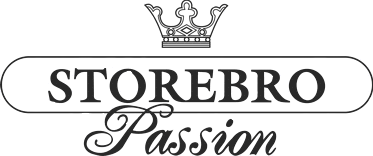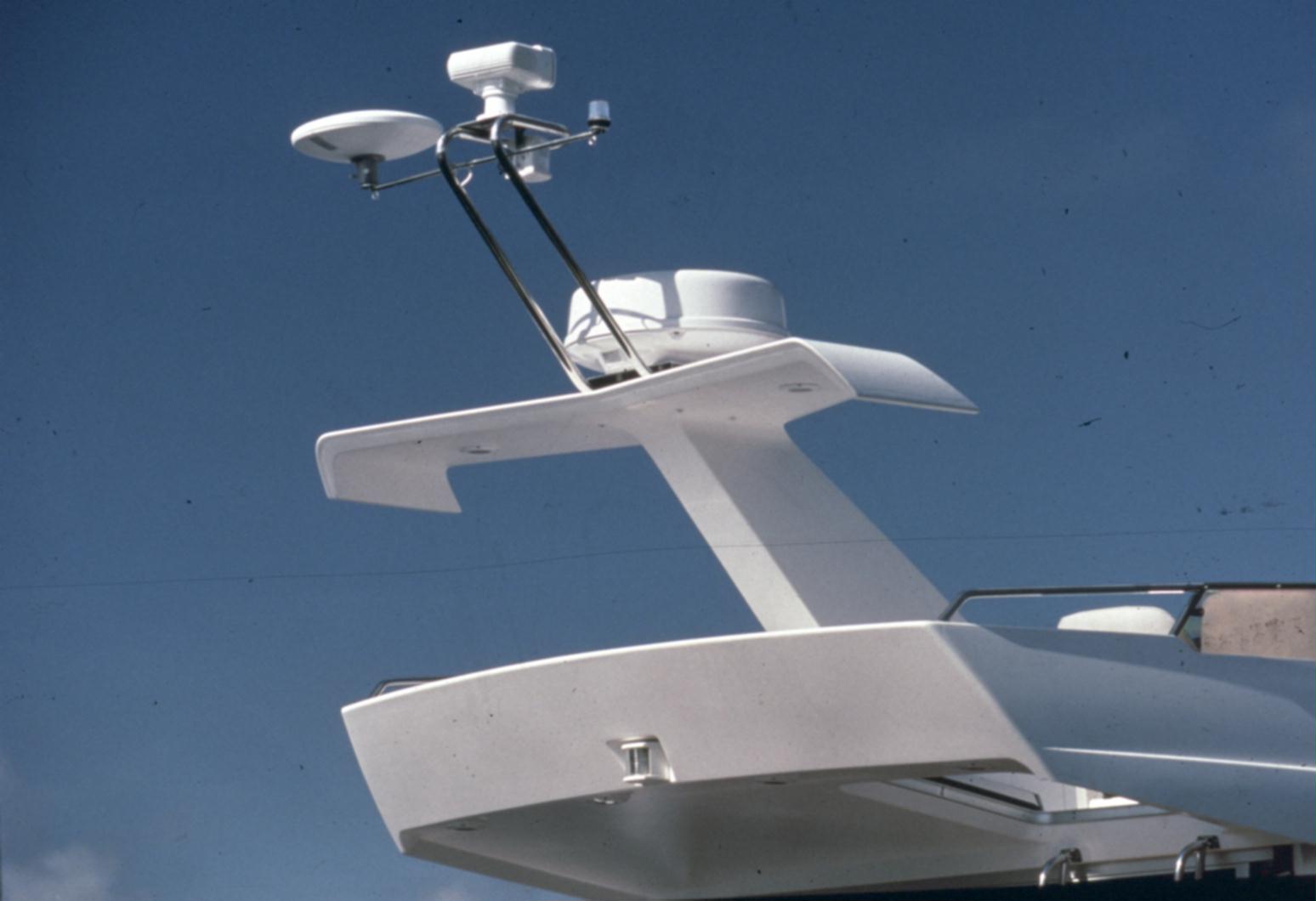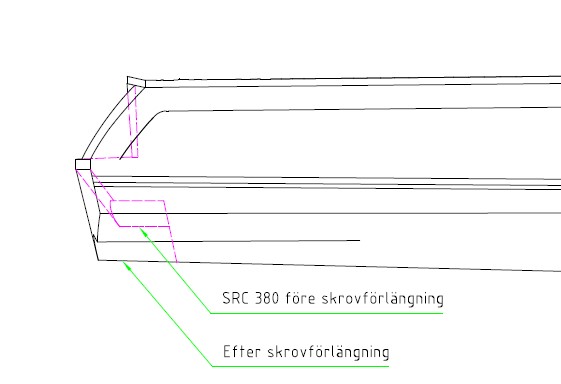

Technical Data | |
| Production period | 1991-1999 - Biscay 1991-1992 - Sportfisherman |
| L.o.a. [m] | 11.43 - 12.03 |
| Beam [m] | 3.77 |
| Draft [m] | 1.00 |
| Height above waterline [m] | 4.50 |
| Freeboard front [m] | 1.28 |
| Freeboard aft [m] | 1.08 |
| Displacement [t] | 7.00 - 9.00 |
| Fuel [l] | 2 x 500 |
| Water [l] | 2 x 200 |
| Voltage [V] | 12 |
| Hull | GRP |
| Number of boats | 74 - Biscay 6 - Sportfisherman |
| Designer | J. Björklund (Hull) Winfried H. Wilke (Design) |
The Storebro Royal Cruiser 380 was the successor of the SRC 340 Biscay. The project originally started under the name SRC 340+. While planning the project then grew to SRC 370 and finally to the SRC 380.

|
The exterior design was slightly enhanced and established a new logo with creation of the "Gullwing"-mast. The layout was nearly unchanged. Significant change was the installation of a separate shower on the port side of the owner's cabin.
However, completely new was the hull construction. After Volvo Penta informed their long-time major customer Storebro and announced the development of new, more powerful engines, Storebro decided to develop new hulls. The new engines would have been too strong for the recent hulls and their cruising characteristics. The newly developed hull differed at first glance by the modified stern with integrated bathing platform. Underwater, however, he offered a completely new design with V-hull and propeller tunnels instead of the previous round bilge construction.
The new "380 Sportfisherman" was especially designed for the Asian and American market. It had a different flybridge-layout for a better surround-view which based on a shortened standard-flybridge. The cockpit was lowered about 15 cm because of the missing hand rails. Additionally, the cockpit was equipped with an ice-box and a basin for live baits. It was a boat for the ambitious fisherman.
Direct successor model was the SRC 395 Biscay.
Engines
For the 380, there were Volvo Penta engines with 230-370 hp (flywheel power). With the cheaper KAMD 42s, however, the ship was latently underpowered. The KAMD 42s had both a turbocharger and a compressor, which was intended to provide rapid acceleration and shut down again at higher revs.
This engine would probably have been more suited to the old hulls. The new hulls, designed for higher speeds, needed a little more speed to run well. The use of the trim tabs was essential with the smaller engine. In addition, the noise level of the KAMD 42 was unpleasant in certain speed regions, as the compressor kept switching on and off.
A total of 18 ships were equipped with KAMD42A and KAMD42P-A. The rest were delivered with TAMD6x.
The situation was different with the TAMD 6x, which made the boat run much better. The last stage of expansion was the TAMD 63P, which easily accelerated the boat, which often weighed up to 10t, to almost 30 knots and simply looked sovereign. Even when manoeuvring, due to the high thrust, it is often sufficient to engage or disengage the gearbox. Additional throttle thrusts are rarely necessary.
Only the last ship with hull number 3761 was delivered with Yanmar 6LYA-STE and 350 hp.
During the first two years of production of the SRC 380 the KAMD 42 were delivered with mechanical MS5B-gearboxes. These gearboxes were switching fast but also broke down quite fast. The power of the KAMD 42 with MS5B transmission was stated at 225 hp on the shaft. Later from S/N 3583 the yard delivered the KAMD 42 with the hydraulic HS1A-gearboxes, which had the handicap to have a second's silence after switching. Not every skipper liked that in every situation. The power at the shaft was reduced to 216 hp.
The TAMD 6x were always delivered with hydraulic ZF MPM/IRM 220A gearboxes.
The first boats with KAMD 42 were built with 2-lever-switching. Later the yard changed to 4-lever-switching which was already used on earlier boats. In 1996, a series of about 4 ships was equipped with the Morse two-lever switches.

|
| SRC 380 hull modification |
In the course of production, it was found that the hull with a full load of the aft stowage compartment did not offer enough upwelling. In the spring of 1993, Storebro tested a boat with a modified hull. The existing hull at the stern underwater was enlarged. Various tests were also performed with changed shaft lengths. Finally, Storebro developed an attachment that extended the hull in the underwater area. This option was also retrofitted to older boats. Details under ""development".
The last four ships (>S/N 3757) were delivered in 1998/1999 with the extended bathing platform of the SRC 395 Biscay.
Trim tabs
The boats with the first hull-version were equipped with the ELTRIM-System. This system showed to be quite error-prone. Either the Cylinders were leaky or the control panel was broken when using the automatic-trim-system. Both could have the effect of driving tilted to port or starboard side.
The 96-model then got the hydraulic system of QL (Volvo Penta). The automatic-trim-system was dropped.
Storebro offered their ships in the classic satin varnished mahogany wood. As an option, some ships were built with a bright ash- or darker walnut-interior in 1991/1992. These options were, however, not very popular. The light wooden interior has been taken up again only with the J32/S32, this time in birch wood.
2025-04-02
Photos and images |
|||||||||||
|
| Engines | Volvo Penta TAMD61A | Volvo Penta KAMD42A | Volvo Penta TAMD62A | Volvo Penta KAMD42P-A | Volvo Penta TAMD63P-A | Volvo Penta KAMD44P | Yanmar 6LYA-STE | |
| Production | 1986-1995 | 1991-1993 * | 1992-1994 | 1994-1997 * | 1994-2005 | 1996-2004 * | 1997-2001 | |
| Fuel | Diesel | Diesel | Diesel | Diesel | Diesel | Diesel | Diesel | |
| Stroke | 4 | 4 | 4 | 4 | 4 | 4 | 4 | |
| No. of cylinders | 6 | 6 | 6 | 6 | 6 | 6 | 6 | |
| Bore | [mm] | 98.43 | 92.00 | 98.43 | 92.00 | 98.40 | 92.00 | 100.00 |
| Stroke | [mm] | 120 | 90 | 120 | 90 | 120 | 90 | 110 |
| Compression ratio | 15.0:1 | 17.8:1 | 15.0:1 | 17.8:1 | 15.0:1 | 16.5:1 | ||
| Displacement | [l] | 5.48 | 3.59 | 5.48 | 3.59 | 5.50 | 3.60 | 5.18 |
| Torque | [Nm] | 904 | ||||||
| Engine output | [kw/(HP)] | 218/(296) *** | 157/(213) | 235/(320) | 157/(213) | 265 - 272/ (360 - 370) | 179/(243) *** | 257/(350) |
| Rotations | [1/min] | 2800 | 3800-3900 | 2800 | 3800-3900 | 2800 | 3700-3900 | 3300 |
| Weight | [kg] | 829 | 500 | 829 | 833 | 515 | 590 **** |
| * All variants of this engine |
| *** Power at the propeller shaft |
| **** Weight without gearbox |
|
|||||||||||||||